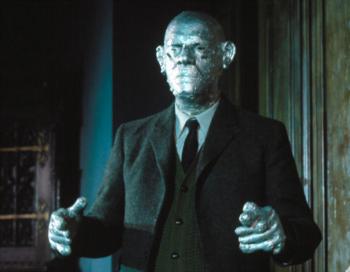
Mad Scientists[ Book Contents]
The Invisible Man [James Whale, 1933]
Claude Rains made his film debut in a role in which he was not seen but heard. Whale treated the story as a comedy, while Rains gave full throat to his character’s growing megalomania. With groundbreaking special effects by John P. Fulton.
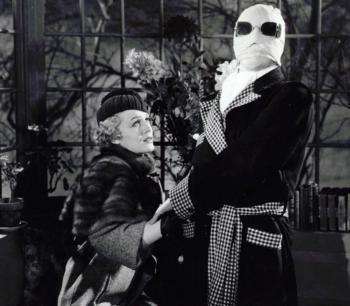
Mad Scientists[ Book Contents]
Island of Lost Souls [Erle C. Kenton, 1932]
A rare photograph of a test make-up. A remarkable mixture of animal parts in a terrific design not seen in the finished film.
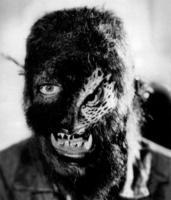
Mad Scientists[ Book Contents]

Charles Laughton gives a fantastic performance as the sadistic Dr. Moreau. Here, he gives instructions to one of his Beast Men.
“We are not men! We are not beasts! We are things!”
The Sayer of the Law (Béla Lugosi), Island of Lost Souls
Mad Scientists[ Book Contents]
Boris Karloff, Colin Clive [ Frankenstein, James Whale, 1931]
The monster (pictured first) and his maker (pictured second) in the first of the three films in which Karloff played the role.

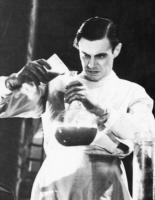
Mad Scientists[ Book Contents]
The Fly [Kurt Neumann, 1958]
Herbert Marshall, Vincent Price, and Charles Herbert discover the terrible truth in the horrifying climax of The Fly.
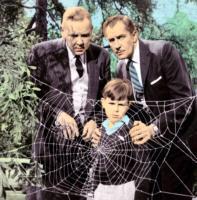
Mad Scientists[ Book Contents]
The Fly [David Cronenberg, 1986]
Jeff Goldblum as mad scientist Seth Brundle in two stages of his metamorphosis into what he terms “Brundlefly.” Cronenberg’s movie is both gross and emotionally powerful.
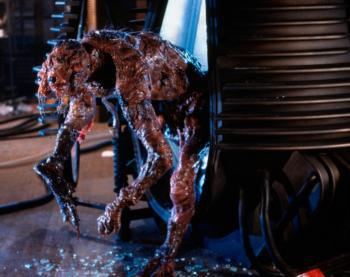
Mad Scientists[ Book Contents]
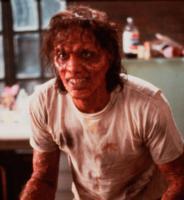
Jeff Goldblum as mad scientist Seth Brundle.
“I’m an insect who dreamed he was a man and loved it. But now the dream is over… and the insect is awake. ”
Seth Brundle (Jeff Goldblum), The Fly
Mad Scientists[ Book Contents]
X: The Man with the X-Ray Eyes [Roger Corman, 1963]
Ray Milland is Dr. James Xavier, whose experimental eyedrops allow him to see more than the human eye should. Once again, the moral is that we should not tamper with the natural order of things. Xavier ends up tearing out his own eyes! One of Corman’s best films, with a terrific performance from Don Rickles as a carnival barker who sees a way to profit from Xavier’s affliction.

Mad Scientists[ Book Contents]
Swamp Thing [Wes Craven, 1982]
Dick Durock as Swamp Thing in the first film based on the DC Comic book character. Durock wore this suit in a sequel and the subsequent television series. As H. L. Menken said, “No one ever went broke underestimating the American public.”
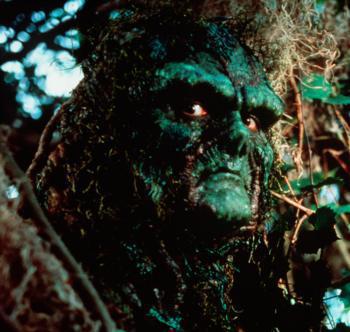
Mad Scientists[ Book Contents]
Sssssss [Bernard L. Kowalski, 1973]
Mad ophiologist Dr. Stoner (Strother Martin) injects snake venom into his daughter’s boyfriend, which transforms him into a malformed, half-man, half-snake.
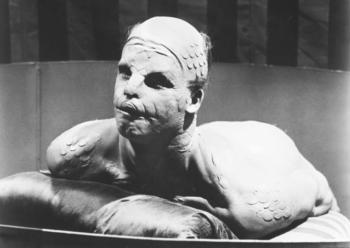
Mad Scientists[ Book Contents]
The Incredible 2-Headed Transplant [Anthony M. Lanza, 1971]
A drive-in classic, in which mad doctor Bruce Dern transplants the head of a criminal onto the body of a big, mentally handicapped guy. Essentially remade as The Thing With Two Heads[Lee Frost, 1972], in which racist Ray Milland’s head is attached to African American Roosevelt Grier’s body, to Rosey’s head’s dismay. The Thing With Two Headsboasts an early cameo by Rick Baker in a two-headed gorilla suit.
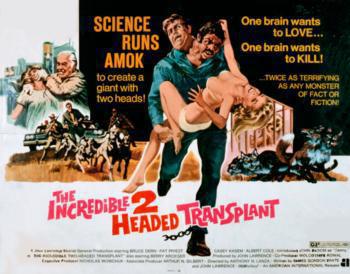
Mad Scientists[ Book Contents]
The Brain That Wouldn’t Die [Joseph Green, 1962]
Dr. Bill Cortner (Jason Evers) attends to the head of his fiancée (Virginia Leith). He keeps her head alive in his basement while he searches for a voluptuous body to replace the one she lost in a car accident! An outrageous movie with a deeply twisted premise.
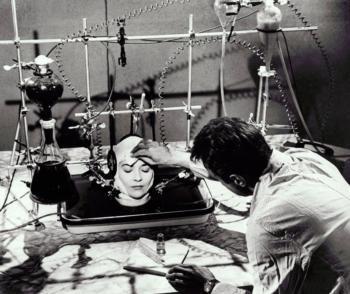
IN CONVERSATION
David Cronenberg
“Directing a movie is similar, in some ways, to a science experiment.”
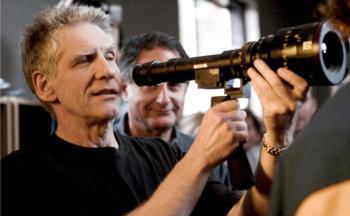
David Cronenberg on the set of A History of Violence[2005].
Mad Scientists[ Book Contents]
JL: David, how would you define a monster?
DC: A monster is a distortion of something that has a normal, non-threatening form. The monstrous form is threatening and disturbing because it is beyond the pale of what we consider normality. A monster is a deformation of what we consider normal and therefore safe.
JL: Do you remember your first encounter with a monster movie?
DC: Bambi[James Algar, Samuel Armstrong, 1942] was scary, and in Bambiit’s the humans who are the monsters. As a kid I identified with Bambi. The hunters who would kill your mother are definitely monsters!
JL: What about the classic monsters like Frankenstein, Dracula, the Wolf Man?
DC: All those guys are deformations of normal humanity. Those are probably the scariest kind of monsters. But the shark in Jaws[Steven Spielberg, 1975] isn’t a monster. It’s an animal designed to kill you. It has no expression, its eyes are dead eyes. It is a killing machine. Does it qualify as a monster? Not really. Same with a T-Rex.
JL: What about Godzilla or a Cyclops or a dragon?
DC: Well, those are different because a Cyclops is a deformation of the human form. And there are some great monstrous creatures in, let’s say, some of the Harry Potterfilms that are based on a Tyrannosaurus rex.
JL: But those dragons are magic!
DC: I think the further away from the human form a monster becomes, the more it becomes like a natural disaster. So, if you’re eaten by a shark, it’s almost like being hit by lightning. There’s no ill will there. It’s just a machine-like animal behaving normally. A natural occurrence.
JL: In Jaws, they did give the shark a personality. They made it malevolent.
DC: That’s true… that was an attempt to mythologize the shark. To make the shark more than just a killing machine. And that’s why Jawswas more successful than the movies about hundreds of piranhas who eat you up. The fact that there was one shark was the key. That’s sort of a Moby Dick thing, to humanize and then mythologize an animal. When a monster is recognizably human, like a Cyclops, that’s when the definition of monster and monstrous and monstrosity becomes very specific and very resonant.